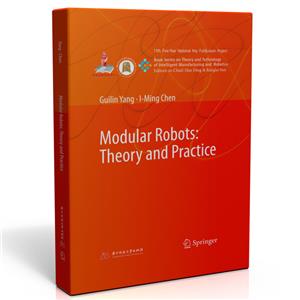-
>
湖南省志(1978-2002)?铁路志
-
>
公路车宝典(ZINN的公路车维修与保养秘籍)
-
>
晶体管电路设计(下)
-
>
基于个性化设计策略的智能交通系统关键技术
-
>
德国克虏伯与晚清火:贸易与仿制模式下的技术转移
-
>
花样百出:贵州少数民族图案填色
-
>
识木:全球220种木材图鉴
Modular Robots: Theory and Practice(模块化机器人理论与应用) 版权信息
- ISBN:9787568073646
- 条形码:9787568073646 ; 978-7-5680-7364-6
- 装帧:一般胶版纸
- 册数:暂无
- 重量:暂无
- 所属分类:>
Modular Robots: Theory and Practice(模块化机器人理论与应用) 本书特色
作者团队为模块化机器人设计研究领域的先驱者,研究成果具有较强的 性。
Modular Robots: Theory and Practice(模块化机器人理论与应用) 内容简介
This book introduces the latest advances in modular robotics, and presents a unified geometric framework for modeling, analysis, and design of modular robots, including kinematics, dynamics, calibration, and configuration optimization. Supplementing the main content with a wealth of illustrations, the book offers a valuable guide for researchers, engineers and graduate students in the fields of mechatronics, robotics, and automation who wish to learn about the theory and practice of modular robots.
Modular Robots: Theory and Practice(模块化机器人理论与应用) 目录
1.1 Motivation
1.2 Past Research and Development Efforts
1.3 Overview of This Book
2 ModuleDesigns
2.1 Module Design Requirements
2.2 Joint Modules
2.2.1 Revolute Joint Modules
2.2.2 Prismatic Joint Modules
2.3 Link Modules
3 Modular Robot Representation
3.1 Graphs
3.1.1 Basic Graph Definitions
3.1.2 Matrix Representation ofGraphs
3.2 Kinematic Graphs
3.3 Reclassification of Links and Joints
3.4 Assembly Incidence Matrix
4 Modular Serial Robot Kinematics
4.1 Introduction
4.2 Geometric Background and the POE Formula
4.2.1 Geometric Background
4.2.2 The POE Formula
4.3 Forward Kinematics
4.3.1 Dyad Kinematics
4.3.2 Forward Kinematics for a Tree-Structured Modular Robot
4.4 Inverse Kinematics
4.4.1 Differential Kinematics Model for a Single Branch
4.4.2 Differential Kinematics Model for a Tree-Structured Robot
4.4.3 Computation Examples
4.4.4 Remarks on Computation Results
5 Kinematic Calibration for Modular Serial Robots
5.1 Introduction
5.2 Kinematic Calibration Models
5.2.1 Basic Calibration Models
5.2.2 An Iterative Least-Squares Algorithm
5.2.3 Kinematic Calibration of Tree-structured Robots
5.3 ComputationExamples
5.3.1 Calibration of a three-module Robot
5.3.2 Calibration of a SCARA Type Robot
5.3.3 Calibration of a Tree-structured Robot
6 Modular Serial Robot Dynamics
6.1 Introduction
6.2 Newton-Euler Equation for a Link Assembly
6.3 Dynamic Formulation for a Tree-Structured Modular Robot
6.3.1 Recursive Newton-Euler Algorithm
6.3.2 Closed Form Equations of Motion
6.3.3 Remarks on the Dynamics Algorithms
6.3.4 Implementation and Examples
6.4 Inverse and Forward Dynamics Problem
6.4.1 Inverse Dynamics
6.4.2 Forward Dynamics
7 Optimization of Modular Serial Robot Configurations
7.1 Introduction
7.2 General Design Methodology
7.3 Optimization Model
7.3.1 Definition of Robot Tasks
7.3.2 Design Parameters and the Search Space
7.3.3 Objective Function
7.3.4 Performance Constraints
7.4 Evolutionary Algorithm
7.4.1 Coding Scheme
7.4.2 AIM Generating Scheme
7.4.3 Genetic Operators on AIMs
7.4.4 Implementation of the Evolutionary Algorithm
7.5 Computation Examples
8 Modular Parallel Robot Kinematics
8.1 Introduction
8.2 Displacement Analysis
8.2.1 Forward Displacement Analysis
8.2.2 Inverse Displacement Analysis
8.3 Instantaneous Kinematics Analysis
……
9 Kinematic Calibration for Modular Parallel Robots
References
Modular Robots: Theory and Practice(模块化机器人理论与应用) 作者简介
Guilin Yang received the B.E. and M.E. degrees from Jilin University, Changchun, Jilin, China, in 1985 and 1988 respectively, and the Ph.D. degree from Nanyang Technological University in 1999, all in mechanical engineering. He is currently the deputy president of Ningbo Institute of Materials Technology and Engineering, Chinese Academy of Sciences. He is also the director of Zhejiang Key Laboratory of Robotics and Intelligent Manufacturing Equipment Technology. His research interests include precision electromagnetic actuators, compliant mechanisms, parallel-kinematics machines, cable-driven robots, modular robots, and robotic automation systems. He has published over 300 technical papers in referred journals and conference proceedings, authored 3 books, and filed 50 patents. He was a recipient of R&D 100 Awards in 2014. I-Ming Chen received the B.S. degree from the Taiwan University, Taipei, Taiwan, in 1986, and the M.S. and Ph.D. degrees from California Institute of Technology, Pasadena, CA, USA, in 1989 and 1994, respectively, all in mechanical engineering. He is currently a Full Professor with the School of Mechanical and Aerospace Engineering, Nanyang Technological University, Singapore. He works on several different topics in robotics, such as mechanism, actuator, human-robot interaction, and logistics and construction robotics. Dr. Chen is a Fellow of Academy of Engineering, Singapore, a Fellow of ASME, a Fellow of IEEE, and the Editor-in-chief of the IEEE/ASME Transactions on Mechatronics. He has published over 430 technical articles in refereed journals, conferences and book chapters, and authored 4 books.
- >
【精装绘本】画给孩子的中国神话
【精装绘本】画给孩子的中国神话
¥17.6¥55.0 - >
有舍有得是人生
有舍有得是人生
¥17.1¥45.0 - >
山海经
山海经
¥17.7¥68.0 - >
中国历史的瞬间
中国历史的瞬间
¥16.7¥38.0 - >
推拿
推拿
¥12.2¥32.0 - >
莉莉和章鱼
莉莉和章鱼
¥13.4¥42.0 - >
人文阅读与收藏·良友文学丛书:一天的工作
人文阅读与收藏·良友文学丛书:一天的工作
¥14.7¥45.8 - >
苦雨斋序跋文-周作人自编集
苦雨斋序跋文-周作人自编集
¥6.9¥16.0
-
黑科技驱动世界的100项技术
¥21.9¥69.8 -
黑科技:驱动世界的100项技术(八品)
¥21.9¥69.8 -
指火控弹道与射击诸元理论
¥38.7¥49 -
智能照明工程手册
¥29.9¥49.8 -
光电直读光谱分析技术与应用
¥38.7¥49 -
服务型制造
¥76.3¥109





















